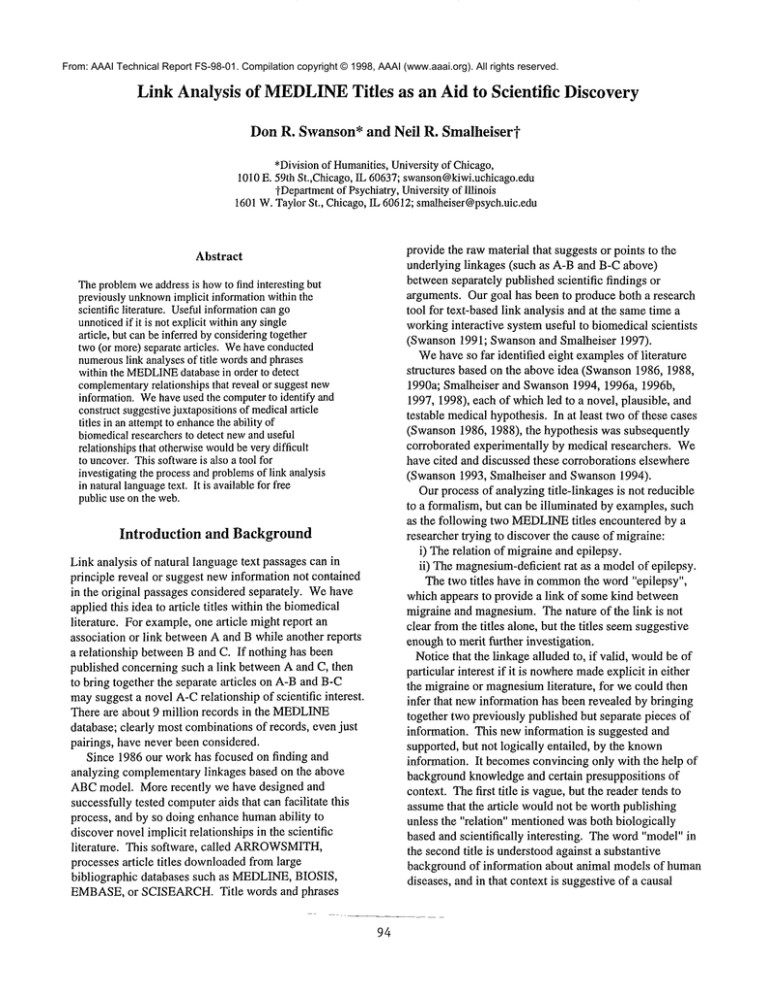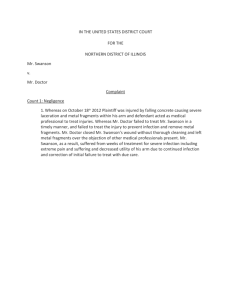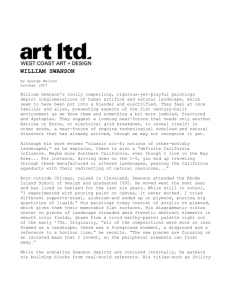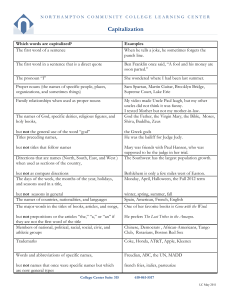
From: AAAI Technical Report FS-98-01. Compilation copyright © 1998, AAAI (www.aaai.org). All rights reserved.
Link Analysis of MEDLINE
Titles as an Aid to Scientific Discovery
Don R. Swanson* and Neil R. Smalheisert
*Divisionof Humanities,Universityof Chicago,
1010E. 59th St.,Chicago, IL 60637;swanson@kiwi.uchicago.edu
tDepartment
of Psychiatry,Universityof Illinois
1601W.Taylor St,, Chicago,IL 60612;smalheiser@psych.uic.edu
provide the raw material that suggests or points to the
underlying linkages (such as A-Band B-C above)
betweenseparately published scientific findings or
arguments. Our goal has been to produce both a research
tool for text-based link analysis and at the sametime a
workinginteractive systemuseful to biomedical scientists
(Swanson 1991; Swansonand Smalheiser 1997).
Wehave so far identified eight examplesof literature
structures based on the above idea (Swanson1986, 1988,
1990a; Smalheiser and Swanson1994, 1996a, 1996b,
1997, 1998), each of whichled to a novel, plausible, and
testable medical hypothesis. In at least twoof these cases
(Swanson1986, 1988), the hypothesis was subsequently
corroborated experimentally by medical researchers. We
have cited and discussed these corroborations elsewhere
(Swanson 1993, Smalbeiser and Swanson1994).
Our process of analyzing title-linkages is not reducible
to a formalism, but can be illuminated by examples, such
as the following two MEDLINE
rifles encountered by a
researcher trying to discover the cause of migraine:
i) The relation of migraine and epilepsy.
ii) The magnesium-deficientrat as a modelof epilepsy.
The two titles have in common
the word "epilepsy",
which appears to provide a link of somekind between
migraine and magnesium.The nature of the link is not
clear fromthe titles alone, but the titles seemsuggestive
enoughto merit further investigation.
Notice that the linkage alluded to, if valid, wouldbe of
particular interest if it is nowheremadeexplicit in either
the migraine or magnesium
literature, for we could then
infer that newinformation has been revealed by bringing
together two previously published but separate pieces of
information. This new information is suggested and
supported, but not logically entailed, by the known
information. It becomesconvincing only with the help of
backgroundknowledgeand certain presuppositions of
context. The first title is vague, but the reader tends to
assumethat the article wouldnot be worth publishing
unless the "relation" mentionedwas both biologically
based and scientifically interesting. The word"model"in
the secondtitle is understoodagainst a substantive
background of information about animal models of human
diseases, and in that context is suggestive of a causal
Abstract
Theproblemweaddressis howto find interesting but
previouslyunknown
implicit informationwithin the
scientific literature. Usefulinformation
cango
unnoticed
if it is not explicit withinanysingle
article, but canbe inferred byconsideringtogether
two(or more)separate articles. Wehaveconducted
numerous
link analysesof title wordsand phrases
within the MEDLINE
databasein order to detect
complementary
relationships that reveal or suggestnew
information.Wehaveused the computerto identify and
constructsuggestivejuxtapositionsof medicalarticle
titles in an attemptto enhance
the ability of
biomedicalresearchersto detect newand useful
relationshipsthat otherwisewouldbe verydifficult
to uncover.Thissoftwareis also a tool for
investigatingthe processandproblemsof link analysis
in naturallanguage
text. It is availablefor free
publicuse on the web.
Introduction
and Background
Link analysis of natural languagetext passages can in
principle reveal or suggest new information not contained
in the original passages considered separately. Wehave
applied this idea to article titles within the biomedical
literature. For example,one article might report an
association or link betweenA and B while another reports
a relationship betweenB and C. If nothing has been
published concerning such a link betweenA and C, then
to bring together the separate articles on A-Band B-C
maysuggest a novel A-Crelationship of scientific interest.
There are about 9 million records in the MEDLINE
database; clearly most combinationsof records, even just
pairings, have never been considered.
Since 1986 our work has focused on finding and
analyzing complementarylinkages based on the above
ABCmodel. More recently we have designed and
successfully tested computeraids that can facilitate this
process, and by so doing enhancehumanability to
discovernovel implicit relationships in the scientific
literature. This software, called ARROWSMITH,
processes article titles downloadedfrom large
bibliographic databases such as MEDLINE,
BIOSIS,
EMBASE,
or SCISEARCH.
Title words and phrases
94
relationship.
The problemwe identify in this exampleis not howto
draw an inference about the possible effect of magnesium
on migraine, but rather howthese two titles could have
been found and brought together in the first place without
knowingin advance that epilepsy might be involved. Any
inferences about the significance or nature of this linkage,
oncethe titles havebeenbroughttogether, are left to the
user.
A MEDLINE
search can of course readily find every
record in the database that mentions both A and C
(magnesiumand migraine), but we are especially
interested in the cases for whichsuch a "direct" search
turns up little or nothing. A conventional database search
cannot identify unknown
indirect links such as epilepsy in
the above example. ARROWSMITH
is designed to solve
that problem.
Stage 1: Uploadthe two input files to the kiwi website
After it receives File C and File A, ARROWSMITH
creates a list of all "important"wordsand phrases
common
to the two files. This list of terms provides the
source for the intermediate linkages, B, within A-B-C
relationships. The distinction betweenwordsthat are
"important" and words that are not is implementedby
means of a 7000-word STOPLIST
(words to be excluded)
compiled in advance by applying humanjudgment, and
then used by the computeras a filter. The output of this
stage is a preliminary list of B-terms,madeavailable to
the user 5-30 minutes(dependingon file sizes) after Files
C and A are received.
Stage 2: Edit the B-list
The preliminary B-list should be edited by the user.
Notwithstanding the STOPLIST
filter, the B-~t often
contains manyterms that the user wouldnot consider
potentially interesting as a B-linkagein the fight of the
particular problemat hand. At the website, the
preliminary B-list appears in a scrollable "option" window
that permits multiple selection of terms. The selected
terms are then deleted from the B-list.
Using the Software
Ourapproachis basedon a series of filters, restrictions,
and strategies that both limit the search space and
circumventthe obviously difficult problemof telling the
computerwhat to look for and howto recognize
complementaryrelationships. The input to the
ARROWSMITH
software consists of two files created by
searching MEDLINE.
The software is divided into five
stages, described below. ARROWSMITH
can be run
(free) froma website that accepts transmitted files as input
at http://ldwi.uchicago.edu
Stage 3: Title-browsing
The edited B-fist is displayed in a windowin which each
B-termis a pointer to the titles fromFile A containing that
term (called the ABtitles). EachABtitle fist contains
pointer to the correspondingset of BCtitles, thus
facilitating a systematic, organizedprocess of point-andclick title-browsing. Successful use of ARROWSMITH
dependson the user’s subject knowledge,ingenuity, and
ability to see promising connections suggested by
comparingABtitles with BCtitles for each B.
Howto preparethe input files
Beginwith a medical disorder or disease (such as
migraine), and conduct a MEDLINE
title-word search.
Download
all titles that contain the word"migraine", (or
that otherwiseexplicitly identify the chosenproblem),
creating File C.
Conducta second MEDLINE
search to identify a target
literature, anddownload
titles that identify it (e.g. titles
with the word"magnesium")to create File A.
Or, if there is no specific A-termthat seemsto merit an
immediatetest, then choosea broad category as a basis
for the MEDLINE
search. This broad search need not be
restricted to title words.In general, categories of external
agents or substances that mayenter the body and have
beneficial or adverse effects on the disorder C are of
interest. Especially importantare dietary factors (or
dietary deficiencies), toxins, and categories of
pharmaceuticalagents or their targets.
Typically, files Aand C contain several thousandtitles.
The website version of ARROWSMITH
is limited to 5000
titles in eachfile. (Largerfiles can be run on request.)
Stage 4: Ranking individual A-terms
Stages 4 and 5 do not apply if File A, above, was based on
a specific substance (such as magnesium).However,
File A was created by searching a broad category, then it
becomesof interest to identify morespecific A-termsthat
occur in the titles of records within that category.
ARROWSMITH
derives, from the ABtitle fist, a list of
words and phrases that becomecandidates for these more
specific terms. Thelist of candidatesis called the A-list.
Eachterm on the A-fist is associated with all B-termsthat
co-occurwith it in the ABtitles. The A-list terms are then
ranked by the numberof associated terms from the B-list.
This methodis a simplified version of the ranking method
discussed previously (Swansonand Smalheiser 1997).
Thus the output of Stage 4 is a ranked A-~t. (Using
95
"migraine"to create File C, and a dietary/deficiency
category to create File A, the word "magnesium"
appearedat or near the top of the resulting A-list.)
The user of ARROWSMITH
can select what appear to
be the most promisingentries from the ranked A-list, and
then, with the help of both subject and citation searching,
investigate any "direct" A-Crelationships that mayhave
already been published (Garfield 1994; Swanson1990b).
If such already knowninformation is scarce or
inadequate, the next step wouldthen be to re-run
ARROWSMITH
beginning again at Stage 1, but now
using a single specific Aas the basis for File A instead of
a broad category.
Patterns
of Complementarity
In studying links that occur in title wordsand phrases, we
have indentified a few regularities or patterns. For
example, the A-Band B-Crelationships largely fall into
two groups that can be called "influence" and "similarity".
The influence of A on B can be expressed in manyways,
including: increases, decreases, promotes,inhibits,
ameliorates, exacerbates, enhances, causes, accelerates,
facilitates, triggers, catalyzes, competeswith, or acts
synergistically. The direction of influence mayalso be
reversed, with B influencing A. The software is indifferent
and symmetricwith respect to the direction of any
relationship. The concept of "similarity" can be important
either alone (A is similar to B and B is similar to C) or
conjunction with "influence": A influences B, and C is
similar to B, thus suggestingthat A might influence C.
(e.g. Magnesium
deficiency triggers or exacerbates
seizures; migraine in somerespects is similar to epilepsy,
suggesting therefore that magnesiumdeficiency may
trigger or exacerbatemigraineattacks.) In addition to the
foregoing two categories, we have encountereda third,
"locale" or "proximity". "A" maybe a drug or other
substancethat is active at a specific site in the body(e.g.
a small region of the brain), B, whileit is also apparent
that disease C manifests a characteristic pathologyat site
B, suggesting then that A mayinfluence C at location B.
The foregoing regularities notwithstanding, natural
languageis richly expressive, and the variety of waysin
which meaningfulbiological linkages can be suggested to
the expert humanobserver is probably so large as to
defeat any attempt to formalize and automate the
recognition and inference process. ARROWSMITH
in its
present form does not attempt to do so, but instead is
designedto organize and display rifles so as to facilitate
humanrecognition of implicit connections. Moreover,
such connections are almost always interpreted not as
conclusions but moreloosely as hypotheses that maybe
plausible enoughto merit further investigation and testing.
ARROWSMITH
is a practical tool that can aid the
biomedicalresearcher. It is also a research tool for
investigating the problemof formalizing the natural
languagetext linkages that occur in titles (and perhaps
abstracts or full text) of medicalarticles.
Stage 5: Editing and groupingterms on the A-list
As was the case for the B-list, the A-list maycontain
manyterms of no interest that should be manuallydeleted.
Stage 5 presents the A-list within a scrollable option
windowthat permits multiple selection. Twomodesof
operationare offered. In the first, all terms selected are
deleted, just as in Stage 2. In the secondmode,all terms
selected are groupedtogether and treated as synonymous
for the purpose of ranking. For example,the A-list might
contain ascorbate, ascorbic acid, and vitamin C. In one
pass through the window,clicking on these three terms
will create a group in whichthe total numberof associated
B-terms from each of the three are combinedinto a single
newtotal which then gives the group a higher rank than
any of the componentA-terms. The user mayalternate
between the deletion modeand the grouping mode,using
each modeas manytimes as desired until satisfied with
the final A-list, whichis then reranked.
Synonym Recognition
Stages 2,3 and 5 dependon the user to recognize and take
into account synonymsand related terms that should be
considered together. Strict synonyms(such as ascorbic
acid and vitamin C) could be handled automatically by
meansof table lookup,but it is clear that the problemis
muchdeeper. Terms that are more loosely related may
serve similar purposes in someparticular context of
interest (e.g. fish oils and eicosapentaenoicacid, or
antioxidants and free radicals). A future version of
ARROWSMITH
will present to the user a list of word
(and phrase) pairs that are candidates for "surrogate
synonyms"that wouldserve as an aid to editing,
browsing,grouping, and ranking in Stages 2, 3, and 5.
Wordswill be paired if they tend to appear in similar
contexts, as defined with the help of 2nd order title-word
co-occurrence data.
Related
Work by Others
This project has been analyzed, enhanced, and
extended in a numberof recent papers (Chen 1993; Cory
1998; Davies 1989; Finn 1998; Garfield 1994; Gordonand
Lindsay 1996; Gordon and Dumais1998; Kostoff 1998;
Rikken 1998; Spasser 1997). Analogous work on
96
Swanson, D.R. and Smalheiser, N.R. 1997. An Interactive
System for Finding ComplementaryLiteratures: a
Stimulusto Scientific Discovery.Artificial Intelligence
91:183-203.
computer-generateddiscovery in chemical reaction
pathwayshas also been reported (Valdes-Perez 1994).
References
Chen, Z, 1993. Let documentstalk to each other: A
computer modelfor connection of short documents, J Doc
49(1):44-54.
Swanson,D.R. 1993. Intervening in the Life Cycles of
Scientific Knowledge.Library Trends 41 (4):606-631.
Swanson, D.R. 1991. ComplementaryStructures in
Disjoint Science Literatures SIGIR91Proceedingsof the
Fourteenth Annual International A CM/SIGIRConference
on Research and Developmentin Information Retrieval
Chicago, Oct 13-16, 1991 ed. A. Bookstein, et. al. New
York: ACM;p. 280-9.
Cory, K.A. 1997. Discovering Hidden Analogies in an
Online Humanities Database. Computersand the
Humanities 31:1-12.
Davies, R. 1989. The creation of new knowledgeby
information retrieval and classification, J Doc45(4):273301.
Swanson, D.R. 1990a. SomatomedinC and Arginine;
Implicit Connections BetweenMutually-Isolated
Literatures. Perspectives in Biology and Medicine, 33(2),
157-186.
Finn, R. 1998. Program Uncovers Hidden Connections in
the Literature. The Scientist 12(10)(May11): 12-13.
Garfield, E. 1994. Linkingliteratures: Anintriguing use of
the Citation Index, Current Contents #21(May23):3-5.
Swanson, D.R. 1990b. The Absence of Co-Citation as a
Clue to Undiscovered Causal Connections. In C.L.
Borgman, ed. Scholarly Communicationand
Bibliometrics [Sage Pub. 1990] Ch. 7, p. 129-137.
Gordon, M.D. and Lindsay, R.K. 1996. Towarddiscovery
support systems: A replication, re-examination, and
extension of Swanson’swork on literature-based
discovery
of It~
a connection
betweenRaynaud’sand fish oil.
J. Ant. Soc.
Sci. 47(2):116-128.
Swanson, D. R. 1988. Migraine and Magnesium:Eleven
Neglected Connections. Perspectives in Biology and
Medicine, 31(4), 526-557.
Gordon, M.D. and Dumais, S. 1998. Using Latent
SemanticIndexing for Literature Based Discovery. J.
Am. Soc. h~ Sci. 49(8):674-685.
Swanson, D. R. 1986. Fish Oil, Raynaud’sSyndrome, and
Undiscovered Public Knowledge.Perspectives in Biology
and Medicine. 30(1):7-18.
Kostoff, R. N. 1998 Science and TechnologyInnovation.
See website at
http://www.dtic.mil/dtic/kostoff/index.html
Valdes Perez, R.E. 1994. Conjecturing hidden entities by
means of simplicity and conservation laws: machine
discovery in chemistry. Artif Intell. 65(2):247-280.
Rikken, F. 1998 Adverse Drug Reactions in a Different
Context: A Scientometric Approachtowards Adverse
Drug Reactions as a Trigger for the Developmentof New
Drugs. Ph.D. diss. Rijksuniversiteit Groningen.
Spasser, M.A.1997. The enacted fate of undiscovered
public knowledge. J. Am. Soc. It~ Sci. 48(8):707-717.
Smalheiser, N.R. and Swanson, D.R. 1998. CalciumIndependent Phospholipase A2 and Schizophrenia.
Archives of General Psychiatry. 55:752-753.
Smalheiser, N.R. and Swanson, D.R. 1996. Indomethacin
and Alzheimer’s Disease, Neurology 46:583.
Smalheiser, N.R. and Swanson,D. R. 1996. Linking
Estrogen to Alzheimer’s Disease: AnInformatics
Approach. Neurology 47:809-810.
Smalheiser, N.R. and Swanson, D.R. 1994. Assessing a
Gap in the Biomedical Literature: MagnesiumDeficiency
and Neurologic Disease, Neurosci Res Commun
15: I-9.
97




